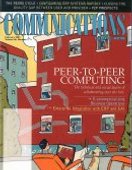Research and Advances Technical and social components of peer-to-peer computing
Feb 1 2003
An End-User Perspective on File-Sharing Systems
P2P file-sharing systems enable their users to share files directly among themselves without the need for a central file server. They form one of the most well-known categories of P2P systems, thanks largely to the Napster controversy and its appeal to the large potential user base. At its peak, Napster boasted a registered user base of 70 million [9] and 1.57 million simultaneous users. Now, after Napster's downfall, over 50 systems have taken its place. The files shared through these systems include not only music files but also videos, audio books, and pictures. P2P file-sharing applications account for five of the top 10 downloads from the download.com Web site, together representing over 4.5 million downloads in the last week of June 2002 alone. Also, as of June 2002, 19% of Americans over age 12 (about 40 million users) have downloaded music files from these systems, according to cyberatlas.internet.com. These systems are interesting in many ways. They blur the distinction between server, client, and router because individual computers fill these roles, communicating and sharing resources without dedicated servers [6]. They challenge the ability to enforce copyright. They form a backbone for other types of P2P applications, such as groupware and content distribution.




